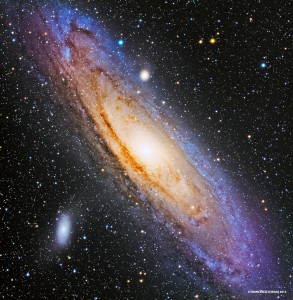Astronomers have discovered 195 compact elliptical galaxies, upping the known number of these weird galaxies sixfold.

Francesco di Biase / S&T Gallery
In the galactic zoo of today’s universe, there’s a breed called the compact elliptical. These are not to be confused with compact cores, which I wrote about last week — compact cores exist in the early universe and can be hundreds of times more massive; they’re probably the progenitors of today’s most massive ellipticals. Compact ellipticals, conversely, are puny balls of old stars, weighing maybe a few billion solar masses. That gives them a mere tenth the mass of the Milky Way’s central bulge.
(And yes, astronomy has confusing nomenclature. Don’t blame the messenger.)
Astronomers have found about 30 of these little pot-bellied galaxies, include M32, one of the Andromeda Galaxy’s galactic entourage. Most lie in clusters, and observers have found debris around some, suggesting that compact ellipticals were once larger but had their outer edges ripped from them by other galaxies. But a couple sulk off by themselves, making the tidal disruption theory problematic: if there’s nothing around to strip material off these galaxies, did they really shrink?
In the April 24th Science, Igor Chilingarian (Smithsonian Astrophysical Observatory and Moscow State University, Russia) and Ivan Zolotukhin (Moscow State University, Russia, and IRAP, France) significantly boost the number of compact ellipticals we know about, reporting their discovery of 195 of these objects. These galaxies exist in clusters (56), groups (128), and in isolation (11).
Given the galaxies’ motions and sizes, the authors suggest that interactions with two or more other galaxies (instead of just one) could sling these diminutive ellipticals into the cosmic outback. That would explain how galaxies created via tidal disruption are out in the sticks, where there aren’t many galaxies to interact with. The isolated compact ellipticals astronomers have found would therefore be runaway galaxies.
But astronomers need to check this theory with rigorous computer simulations — it’s by no means conclusive. Other researchers have suggested that isolated compact ellipticals might arise when dwarf galaxies merge. With no additional stuff nearby to feed on, the compact ellipticals would simply stop growing and never reach full size. This new, larger population of compact ellipticals will thus help astronomers explore their origin.
Reference: I. Chilingarian and I. Zolotukhin. “Isolated compact elliptical galaxies: Stellar systems that ran away.” Science. April 24, 2015.
 0
0
Comments
You must be logged in to post a comment.